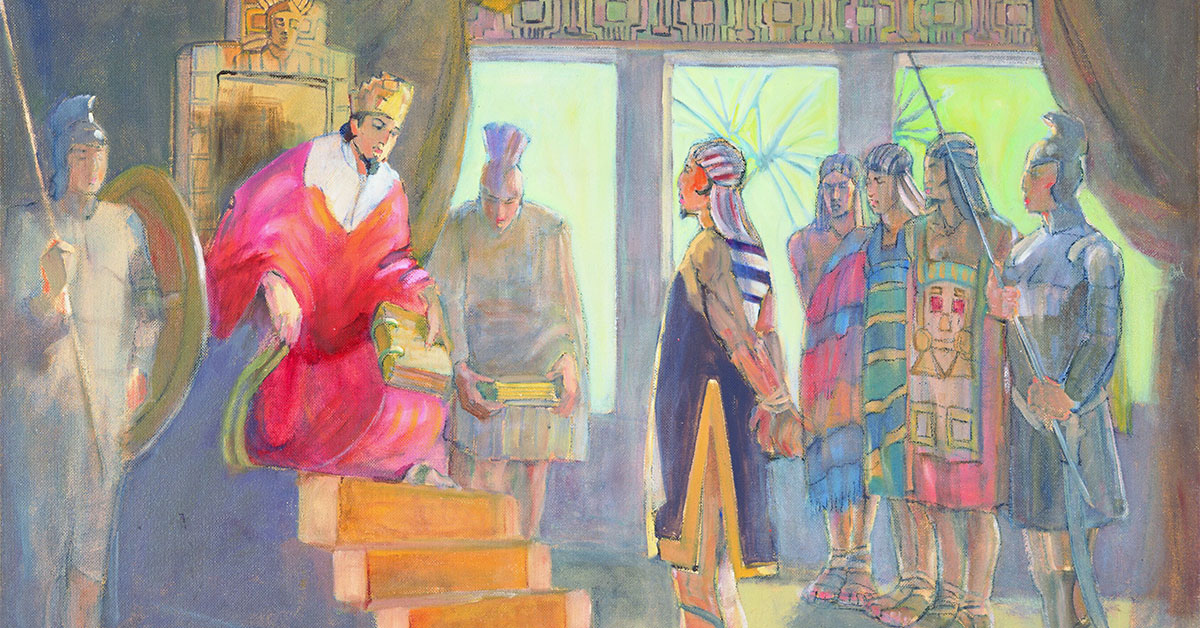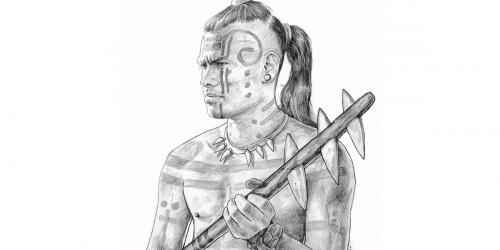You are here
Book of Mormon Central is in the process of migrating to our new Scripture Central website.
We ask for your patience during this transition. Over the coming weeks, all pages of bookofmormoncentral.org will be redirected to their corresponding page on scripturecentral.org, resulting in minimal disruption.

Scripture Block
Mosiah 7–10
April 27–May 3. “A Light … That Can Never Be Darkened”
KnoWhys
Recommended Resources
Learn about the Book of Mormon with verse by verse commentaries from renowned Book of Mormon scholars like John W. Welch and Brant A. Gardner in the ScripturePlus app. Read this week's KnoWhy connected with the Come Follow Me curriculum, and watch a video elucidating an insight in this week's scripture reading.
Reading Plan
Structure your personal scripture study by following a multimedia, day by day plan. Each day's assignment includes the required scripture passages from the Come Follow Me curriculum, as well as suggestions for additional resources to bring context and understanding to your study. To dive deep, skip down to "Additional Resources" for a bibliography on Mosiah 7–10.
Monday
- Scripture: Mosiah 7:1–16
-
Quote: “’In scripture, the number [forty] represents a period of trial, testing, probation, or mourning’ (Gaskill, The Lost Language of Symbolism, 137). Ammon’s group traveled forty days to assist Limhi’s people who were in a period of trial, testing, and morning in their bondage.
The Bible illustrates a related symbol for forty. ‘In Noah’s time, forty days of rain … made a new beginning for humanity….Christ fasted forty days before beginning his ministry… These and other biblical parallels create a typology of deliverance following forty days of tribulation….When Ammon1 arrives, Limhi and his people are sunk in despair...Having suffered greatly and having repented of their sins, they are now rescued.’” Larsen, Val. “In His Footsteps: Ammon1 and Ammon2.” Interpreter: A Journal of Mormon Scripture vol. 3 (2013): 94–96. - Quote: “In all of Limhi's words recorded in the Book of Mormon there is not a hint that he was reluctant to give up his throne. His people's safety, righteousness, and happiness were more important to him, apparently, than power. When Ammon came, offering the possibility of escape from the land of Nephi and a return to Zarahemla, Limhi said: ‘I will rejoice; and…I will cause that my people shall rejoice also’-rejoice even if they became slaves to the Nephites, for almost anything was better than their current situation! (Mosiah 7:14-15.) Limhi didn't hesitate. As he had used his power wisely, for the benefit of his people, so now, for the benefit of his people, he gladly began a series of events that led to his giving up that power.” Card, Orson Scott. “Three Kings and a Captain: Nephite Leaders in the Land of Nephi.” Ensign, January 1977, 82.
- Video: Why Are Mormon's Extensive Quotations of Limhi Significant? (1:01)
Explore Further
Tuesday
- Scripture: Mosiah 7:17–33
- Quote: “The society in which the Nephite kings ruled was a temple-centered one. The king made important announcements at the temple (Mosiah 1:18; 2:5-6) both in the society at Zarahemla and in Zeniff's derivative society in the land of Nephi (Mosiah 7:17). When Jesus Christ appeared to the Nephites, he came to them at the temple in the land of Bountiful (3 Nephi 11:1-10). Even king Noah lavished money upon his temple in which his chosen priests served (Mosiah 11:10-11).” Peterson, Daniel C. “Priesthood in Mosiah.” Essay. In The Book of Mormon: Mosiah, Salvation Only through Christ, edited by Monte S. Nyman and Charles D. Tate, 193. Salt Lake City, UT: Greg Kofford Books, 1991.
-
Quote: “Zeniff’s over-zealousness led him to make an unwise agreement with one whose ultimate purpose was to bring these Nephites into bondage.”
“While we question the wisdom of Zeniff, we could ask if the same kind of zeal causes people today to make agreements or sign contracts that will ultimately place them in political or financial bondage. Individuals can be over-zealous for material possessions, or they can become so involved in a cause or in their work that they begin to neglect the weightier matters that are most important, such as family, church, and service to others.” Williams, Clyde J. “Deliverance from Bondage.” Essay. In The Book of Mormon: Mosiah, Salvation Only through Christ, edited by Monte S. Nyman and Charles D. Tate, 263. Salt Lake City, UT: Greg Kofford Books, 1991. - KnoWhy 369: How Do the Covenants in the Scriptures Apply to Me Today?
Wednesday
- Scripture: Mosiah 8:1–12
- Quote: “The situation in which Limhi and his people found themselves is a type, a representation of the predicament that the scattered remnants of Israel are in the world over. They too must first accept that message previously rejected by their fathers if they are to be liberated from the spiritual darkness that is theirs. Only then can they expect the Lord to free them from their temporal bondage and allow them to return, as Limhi's people would, to the land and people they left.” McConkie, Joseph Fielding, and Robert L. Millet. Doctrinal Commentary on the Book of Mormon, 2:188. Salt Lake City, UT: Deseret Book, 2007.
- Quote: “After King Benjamin taught his people, ‘he dismissed the multitude, and they returned, every one, according to their families, to their own houses.’ In his day, King Limhi did the same. After teaching and ministering to the people at the temple in Bountiful, the Savior entreated the people, ‘Go ye unto your homes, and ponder upon the things which I have said, and ask of the Father, in my name, that ye may understand, and prepare your minds for the morrow, and I come unto you again.’” Hales, Robert D. “General Conference: Strengthening Faith and Testimony.” General Conference October 2013.
Thursday
- Scripture: Mosiah 8:13–21
- KnoWhy 86: Why is a Seer Greater than a Prophet?
- Video: Evidences of the Book of Mormon: Translation (7:26)
Explore Further
- KnoWhy 538: Did a “Magic World View” Influence the Coming Forth of the Book of Mormon?
- KnoWhy 454: What Do the Kinderhook Plates Reveal About Joseph Smith’s Gift of Translation?
Friday
- Scripture: Mosiah 9:1–19
- KnoWhy 87: How Can Barley in the Book of Mormon Feed Faith?
- KnoWhy 472: Why Does the Book of Mormon Mention Cimeters?
Saturday
- Scripture: Mosiah 10:1–10
- Quote: “Elder Robert D. Hales taught that ‘joyfully living within our means and preparing for the ups and downs of life’ helps us to ‘be ready for the rainy-day emergencies when they come into our lives.’ He added, ‘happy is the man who lives within his means and is able to save a little for future needs. As we live providently and increase our gifts and talents, we become more self-reliant. Self-reliance is taking responsibility for our own spiritual and temporal welfare and for those whom Heavenly Father has entrusted to our care’” Hales, Robert D. “A Gospel Vision of Welfare: Faith in Action.” Basic Principles of Welfare and Self-Reliance, 1-2. Salt Lake City, UT: The Church of Jesus Christ of Latter-day Saints, 2009.
- Quote: “Impressive were King Zeniff's heroics while defending his kingdom against Lamanite invasion [including guards “round about the land” and spies, see Mosiah 10:2, 7]…. When the Lamanites finally attacked, Zeniff led virtually the entire male population into battle… Thus, although Zeniff's people went ‘up in the strength of the Lord to battle’ (Mosiah 10:10), victory was due in no small part to King Zeniff's tactical prowess and battlefield valor” Kerr, Todd R. “Ancient Aspects of Nephite Kingship in the Book of Mormon.” Journal of Book of Mormon Studies 1, no. 1 (1992): 90.
Sunday
- Scripture: Mosiah 10:11–22
- Quote: “Nephite kingship was … connected with and was even symbolized or legitimized by possession of certain material objects…. Nephi took the brass plates with him when he abandoned the land of Nephi… The Lamanites … claimed that by taking them Nephi had ‘robbed them,’… (Mosiah 10:15-16; compare 2 Nephi 5:3; Alma 20:10, 13). When Benjamin transferred the kingdom to his son Mosiah, he gave Mosiah the brass plates, as well as the plates of Nephi, the sword of Laban, and the Liahona.” Peterson, Daniel C. “Priesthood in Mosiah.” Essay. In The Book of Mormon: Mosiah, Salvation Only through Christ, edited by Monte S. Nyman and Charles D. Tate, 191. Salt Lake City, UT: Greg Kofford Books, 1991.
- Quote: “The characteristics of the Lamanites and their hatred of the Nephites [see Mosiah 10:11-17] reinforce a consistent, ugly picture of a people whose false traditions have led them to a cursed condition. It is a study of how ignorance and prejudice are passed on. Some of what we see in the world today, one group advocating hatred toward another group, is captured in verse 17.” Ogden, D. Kelly, and Andrew C. Skinner. Verse by Verse: The Book of Mormon, 1:332. Salt Lake City, UT: Deseret Book, 2011.
Additional Resources
Mosiah 7
Peterson, Daniel C. “Priesthood in Mosiah.” In The Book of Mormon: Mosiah, Salvation Only Through Christ, edited by Monte S. Nyman and Charles D. Tate, Jr., 187–210. Provo, UT: Religious Studies Center, Brigham Young University, 1991.
Gee, John. “Limhi in the Library.” Journal of Book of Mormon Studies 1, no. 1 (1992): 54–66.
Welch, John W., and Greg Welch. “Journeys Indicating Distances.” In Charting the Book of Mormon: Visual Aids for Personal Study and Teaching. Provo, UT: Foundation for Ancient Research and Mormon Studies, 1999, chart 152.
Welch, John W., and Greg Welch. “Further Details in the Land of Nephi.” In Charting the Book of Mormon: Visual Aids for Personal Study and Teaching. Provo, UT: Foundation for Ancient Research and Mormon Studies, 1999, chart 154.
Welch, John W., and Greg Welch. “Nephite and Lamanite Kings.” In Charting the Book of Mormon: Visual Aids for Personal Study and Teaching. Provo, UT: Foundation for Ancient Research and Mormon Studies, 1999, chart 32.
Mosiah 7:1
Brandley, J. Theodore. “The City of Lehi-Nephi Name Change.” The Interpreter Foundation Blog (August 9, 2017).
Mosiah 7:1–5
Welch, John W., and Greg Welch. “Twelve Journeys between the Cities of Nephi and Zarahemla.” In Charting the Book of Mormon: Visual Aids for Personal Study and Teaching. Provo, UT: Foundation for Ancient Research and Mormon Studies, 1999, chart 153.
Mosiah 7:3
Larsen, Val. “In His Footsteps: Ammon 1 and Ammon 2.” Interpreter: A Journal of Mormon Scripture 3 (2013): 85–113.
Mosiah 7:7–8
Welch, John W., and Greg Welch. “Legal Cases and Procedures in the Book of Mormon.” In Charting the Book of Mormon: Visual Aids for Personal Study and Teaching. Provo, UT: Foundation for Ancient Research and Mormon Studies, 1999, chart 121.
Mosiah 7:9
Book of Mormon Central. “Why Are Mormon's Extensive Quotations of Limhi Significant? (Mosiah 7:9).” KnoWhy 85 (April 25, 2016).
Mosiah 7:10
Welch, John W., and Greg Welch. “References to Nephite Fortifications Recorded in the Book of Mormon.” In Charting the Book of Mormon: Visual Aids for Personal Study and Teaching. Provo, UT: Foundation for Ancient Research and Mormon Studies, 1999, chart 142.
Mosiah 7:15–22
Williams, Clyde J. “Deliverance from Bondage.” In The Book of Mormon: Mosiah, Salvation Only Through Christ, edited by Monte S. Nyman and Charles D. Tate, Jr., 261–274. Provo, UT: Religious Studies Center, Brigham Young University, 1991.
Mosiah 7:18–19
Spendlove, Loren Blake. “Limhi's Discourse: Proximity and Distance in Teaching.” Interpreter: A Journal of Mormon Scripture 8 (2014): 1–6.
Tate, George S. “The Typology of the Exodus Pattern in the Book of Mormon.” In Literature of Belief: Sacred Scripture and Religious Experience. Edited by Neal E. Lambert. Provo, UT: Religious Studies Center, Brigham Young University, 1981, 245–62.
Brown, S. Kent. “The Exodus Pattern of the Book of Mormon.” In From Jerusalem to Zarahemla: Literary and Historical Studies of the Book of Mormon, 75–98. Provo, UT: Religious Studies Center, Brigham Young University, 1998.
Brown, S. Kent. “The Exodus Pattern of the Book of Mormon.” BYU Studies Quarterly 30, no. 3 (1990): 111–126.
Boehm, Bruce J. “Wanderers in the Promised Land: A Study of the Exodus Motif in the Book of Mormon and Holy Bible.” Journal of Book of Mormon Studies 3, no. 1 (1994): 187–203.
Mosiah 7:22
Sorenson, John L., and Robert F. Smith. “Barley in Ancient America.” In Reexploring the Book of Mormon, edited by John W. Welch, 130–132. Provo, UT/Salt Lake City: FARMS/Deseret Book, 1992.
Sorenson, John L. “When Lehi’s Party Arrived in the Land, Did They Find Others There?” Journal of Book of Mormon Studies 1, no. 1 (1992): 1–34.
Mosiah 7:25
Book of Mormon Central. “How Do the Covenants in the Scriptures Apply to Me Today? (Mosiah 7:25).” KnoWhy 369 (October 3, 2017).
Mosiah 8
Peterson, Daniel C. “Priesthood in Mosiah.” In The Book of Mormon: Mosiah, Salvation Only Through Christ, edited by Monte S. Nyman and Charles D. Tate, Jr., 187–210. Provo, UT: Religious Studies Center, Brigham Young University, 1991.
Welch, John W., and Greg Welch. “Nephite and Lamanite Kings.” In Charting the Book of Mormon: Visual Aids for Personal Study and Teaching. Provo, UT: Foundation for Ancient Research and Mormon Studies, 1999, chart 32.
Mosiah 8:9
Reeve, Jr., Rex C. “The Book of Mormon Plates.” In The Book of Mormon: First Nephi, The Doctrinal Foundation, edited by Monte S. Nyman and Charles D. Tate, Jr., 99–111. Provo, UT: Religious Studies Center, Brigham Young University, 1988.
Welch, John W., and Greg Welch. “Sources behind the Book of Ether.” In Charting the Book of Mormon: Visual Aids for Personal Study and Teaching. Provo, UT: Foundation for Ancient Research and Mormon Studies, 1999, chart 15.
Mosiah 8:12
Book of Mormon Central. “What Do We Know About the “Anthon Transcript”? (Mosiah 8:12).” KnoWhy 515 (May 9, 2019).
Book of Mormon Central. “What Do the Kinderhook Plates Reveal About Joseph Smith’s Gift of Translation? (Mosiah 8:12–13).” KnoWhy 454 (July 31, 2018).
Mosiah 8:13
Book of Mormon Central. “Did a “Magic World View” Influence the Coming Forth of the Book of Mormon? (2 Nephi 27:26).” KnoWhy 538 (October 31, 2019).
Book of Mormon Central. “Were Joseph Smith’s Translation Instruments Like the Israelite Urim and Thummim? (Alma 37:24).” KnoWhy 417 (March 20, 2018).
Book of Mormon Central. “Which Nephite King Had the Gift of Interpretation? (Mosiah 21:28).” KnoWhy 99 (May 13, 2016).
Book of Mormon Central. “Why Did the Book of Mormon Come Forth as a Miracle? (2 Nephi 27:23).” KnoWhy 273 (February 10, 2017).
Book of Mormon Central. “Why Was a Stone Used as an Aid in Translating the Book of Mormon? (Alma 37:23).” KnoWhy 145 (July 18, 2016).
Callister, Paul Douglas. Kingship and Seer Stones: A Comparison of European Regalia and LDS Scriptural Accounts of Oracular Objects., 2010.
Hoskisson, Paul Y. “Urim and Thummim.” In Encyclopedia of Mormonism, Edited by Daniel H. Ludlow.
Jolley, Elliot. “Gazelem the Jaredite.” Interpreter: A Journal of Latter-day Saint Faith and Scholarship 27 (2017): 85–105.
Spencer, Stan. “What Did the Interpreters (Urim and Thummim) Look Like?” Interpreter: A Journal of Latter-day Saint Faith and Scholarship 33 (2019): 223–256.
Tvedtnes, John A. “Unanswered Questions in the Book of Mormon.” In The Most Correct Book: Insights from a Book of Mormon Scholar, 317–327. Salt Lake City: Cornerstone Publishing, 1999.
Walker, Steven C. “Seer.” In Encyclopedia of Mormonism, Edited by Daniel H. Ludlow. Vol. 3. New York: Macmillan, 1992.
Mosiah 8:15
Book of Mormon Central. “Why is a Seer Greater than a Prophet? (Mosiah 8:15).” KnoWhy 86 (April 26, 2016).
Mosiah 9
Welch, John W., and Greg Welch. “Flashbacks in the Book of Mosiah.” In Charting the Book of Mormon: Visual Aids for Personal Study and Teaching. Provo, UT: Foundation for Ancient Research and Mormon Studies, 1999, chart 29.
Welch, John W., and Greg Welch. “Nephite and Lamanite Kings.” In Charting the Book of Mormon: Visual Aids for Personal Study and Teaching. Provo, UT: Foundation for Ancient Research and Mormon Studies, 1999, chart 32.
Mosiah 9:2
Bokovoy, David E. and Pedro Olavarria. “Zarahemla: Revisiting the ‘Seed of Compassion.’” Insights: A Window on the Ancient World 30, no. 5 (2010): 2–3.
Mosiah 9:5
Bowen, Matthew L. “’Possess the Land in Peace’: Zeniff’s Ironic Wordplay on Shilom.” Interpreter: A Journal of Latter-day Saint Faith and Scholarship 28 (2018): 115–120.
Mosiah 9:9
Book of Mormon Central. “How Can Barley in the Book of Mormon Feed Faith? (Mosiah 9:9).” KnoWhy 87 (April 27, 2016).
Sorenson, John L., and Robert F. Smith. “Barley in Ancient America.” In Reexploring the Book of Mormon, edited by John W. Welch, 130–132. Provo, UT/Salt Lake City: FARMS/Deseret Book, 1992.
Mosiah 9:16
Book of Mormon Central. “Why Does the Book of Mormon Mention Cimeters? (Mosiah 9:16).” KnoWhy 472 (October 2, 2018).
Mosiah 10
Mosiah 10:4–5
Sorenson, John L. “The New World Promised Lands Economic Base.” Insights: A Window on the Ancient World 23, no. 5 (2003):
Mosiah 10:12–17
Reynolds, Noel B. “Nephi’s Political Testament.” In Rediscovering the Book of Mormon: Insights That You May Have Missed Before. Edited by John L. Sorenson and Melvin J. Thorne. Provo and Salt Lake City, UT: Deseret Book and The Foundation for Ancient Research and Mormon Studies, 1991.




